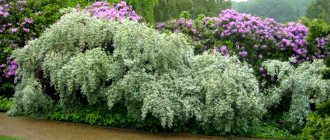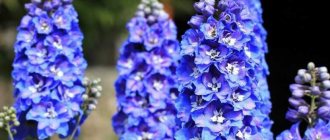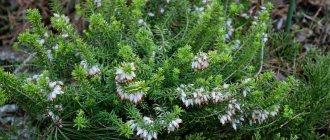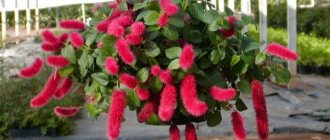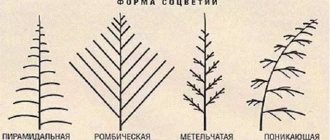Features of caring for hazelnuts
The shrub does not require careful care. Having planted a bush just once, you can collect a nut rich in vitamins and oils for decades.
To grow a fruit plant in a summer cottage, you need to perform a small number of procedures. One of them is the choice of seedling. It is advisable to buy an annual or biennial plant from a city nursery. The bush will already be adapted to climatic conditions. When examining the bushes, you need to be able to distinguish hazelnuts from wild hazel.
You should not buy a plant obtained from a seed. Layering is preferable. The difference between seedlings is in the rhizome. Layers are fibrous. You need to decide where to place the hazelnuts.
What are the benefits of hazelnuts: composition and properties for the benefit of the body.
Compared to the calorie content of meat and fish products, hazelnuts are superior in nutritional value, although they contain fewer carbohydrates. The high calorie content is ensured by the presence of proteins and fats in hazelnuts. 100 grams of nuts contain 670 kcal. Of them:
- fat – 61 g;
- proteins – 14 g;
- carbohydrates – 17 g;
- water – 5.5 g;
- ash – 2.4 g;
- fiber – 11 g.
Hazel nuts contain many vitamins. For example, vitamin E - up to 17.5 mg per 100 g, vitamin B3 - from 1.5 to 5 mg, vitamin B5 - up to 1.0 mg.
Hazelnuts contain many minerals. These are manganese, chromium, boron, vanadium, silicon, copper, cobalt, molybdenum, magnesium, zirconium, phosphorus, potassium, rubidium, strontium, nickel, iron, zinc, sulfur, calcium. The amount of potassium in 100 g of nuts is about 700 mg, magnesium – 165-170 mg, phosphorus – 300 mg, calcium – 115-120 mg.
The valuable composition of hazel nuts allows them to be used as a remedy, as well as to prevent the development of diseases. Eating hazelnuts is beneficial for pregnant women.
Place and season for planting
The shrub grows on flat ground. Walnut is characterized by a shallow root system, thanks to which the crop strengthens the slopes.
The shrub loves moisture, so the planting site should be near a river or pond. An adult bush is spreading, dense and grows up to 5 meters in height, so it needs a spacious, open place with good lighting.
Hazelnuts are afraid of draft winds and open sun. The harvest depends on the lighting. The fruit crop takes root and grows on any soil, with the exception of sand, swamp and salty soil. Hazelnuts develop better on loose, nutrient-rich, neutral soil.
Hazelnuts can be planted in mid-autumn in still warm and moist soil. So, in the spring the roots of the shrub will be restored, and it will be ready for reproduction. When planting a bush in early spring, the seedlings require abundant moisture, since during the growth process the root system absorbs it abundantly. Over a long period of growth, the hazelnut crown increases significantly, so seedlings should be planted at a distance of 6 meters from each other. The exception is shrubs intended as decorative hedges .
How to grow frost-resistant hazelnuts on your own plot
Hazelnuts are a very tasty and incredibly healthy nut with large, sweet kernels that contain truly unique substances and microelements necessary for the human body, and primarily for brain cells.
Previously, hazelnuts were grown exclusively in the southern regions of the country, but after the creation of modern frost-resistant varieties, amateur gardeners from more northern regions became interested in them.
Today, seedlings of frost-resistant hazelnut varieties are in great demand among gardeners in the North-Western and Central regions, the Urals, Siberia and the Far East.
And everywhere it grows beautifully and produces high yields of incredibly tasty nuts. Hazelnuts do not require any too careful care. On the contrary, he is quite unpretentious.
But there are certain subtleties when planting and growing it, without knowing which you cannot get a good harvest of nuts.
Therefore, today we will talk in detail about how to properly plant and grow hazelnuts on your plot, taking into account its characteristics and local soil and climatic conditions.
FROM THE HISTORY OF HAZELNUT
Hazelnut is a very ancient plant. Archaeological excavations indicate that it was eaten by primitive people. Due to its high calorie content, it helped primitive people survive during the Ice Age.
There are references to this nutritious and medicinal nut in the works of ancient Roman and ancient Greek philosophers and historians. They attributed magical properties to hazelnuts and proposed them as the main ingredient in the elixir of immortality.
More than six thousand years ago, hazelnuts began to be grown in the Caucasus and South-West Asia.
At the beginning of the last century, industrial cultivation of hazelnuts was carried out in Turkey, Greece, Italy, Spain, Cyprus and the USA.
In our country, industrial hazelnut plantations were located in Azerbaijan, the Caucasus, Crimea and other southern regions of the USSR.
The idea of creating northern hazelnut varieties belongs to the great Russian breeder I.V. Michurin. He managed to create the first domestic hazelnut varieties, using frost-resistant hazel varieties and large-fruited southern hazelnut varieties as parents.
Now this work is successfully continued by the country's largest research centers.
USEFUL PROPERTIES OF HAZELNUTS
Hazelnuts are simply unique in their composition of nutrients, vitamins and microelements.
The core mainly consists of various fatty acids, including agrinin and linoleic acid, which is not produced in the human body and can only be supplied to it through food. But it is she who is involved in the formation of cell membranes, as well as in protein and fat metabolism.
Hazelnut kernels are rich in trace elements: potassium, magnesium, calcium, sodium, sulfur, phosphorus, iron, cobalt, manganese, iodine, copper, fluorine, zinc, germanium and selenium.
Due to the high content of manganese, copper, iron, calcium, the entire group of vitamin B, as well as vitamin K, regular consumption of hazelnuts helps cleanse and strengthen blood vessels, normalize blood pressure, reduce the content of sugar, uric acid, prothrombin and bilirubin in the blood.
Hazelnuts are an excellent source of vegetable protein (containing up to 20%, and it is 1.5 times higher in calories than animal protein) and nut oil.
We recommend that all vegetarians, regardless of age, include hazelnuts in their diet. The mineral salts and unique microelements contained in this nut will improve the smooth functioning of all your organs and systems.
Hazelnuts are recommended to be given to children and adolescents, as they activate the brain, improve memory, concentrate attention and ensure speed of reactions.
Hazelnuts are an integral part of the diet of astronauts and military pilots.
This nut is certainly used in the treatment of stress and body fatigue syndrome. In the spring, when many residents of the northern regions suffer from vitamin deficiency, hazelnuts provide powerful support to the body, saturate it with energy, and protect the nervous and vascular systems from destruction.
In addition, this nut prevents the development of cancer, removes toxins, waste and other harmful substances from the body, strengthens bone and muscle tissue, restores liver cells, and prevents the accumulation of cholesterol in blood vessels.
BIOLOGICAL PORTRAIT
Important note. Never confuse hazelnuts with hazel. He is its cultivated, large-fruited form.
That is why we do not recommend that you buy hazelnut seedlings at roadside markets and small nurseries. There you will most likely be given hazelnuts as hazelnuts, the nuts of which are much smaller and not so rich in nutrients and vitamins.
And modern frost-resistant varieties of hazelnuts can only be offered to you in large agricultural companies or nurseries.
Hazelnut is a deciduous shrub or tree (less common) up to 5 m high, belonging to the hazel genus of the Birch family.
Its crown is very dense and wide. The bark of an adult hazelnut is smooth, silver-gray in color with transverse lines. In young plants it is brownish-red.
The leaves are large (up to 12 cm in length), green with jagged edges. The ends are pointed, near the petiole - heart-shaped. In autumn they acquire a golden beige color.
Hazelnut is a monoecious plant, wind-pollinated, so it needs cross-pollination to form fruits. Male flowers are long reddish catkins, collected in inflorescences of 2–4 pieces. They scatter yellow pollen abundantly, which, falling on the female flowers of another plant, pollinates them.
Female flowers are formed inside the buds on short shoots. They can only be noticed by the small red stigma “tubercles” protruding from the buds.
In connection with the above, if you want to get a harvest of nuts, then plant 2 - 3 plants on the plot.
The fruit itself is a light brown nut with a large, tasty kernel and a woody pericarp. Depending on the variety, it can have a different shape (round, heart-shaped, oblong).
Hazelnuts ripen by mid-September - early October (different varieties - at different times).
Fruiting begins in the third year after planting.
Nuts can be stored for a long time – up to 10 months. Hazelnuts are long-lived. It can grow and bear fruit in one place for at least 70 years.
HOW TO GROW HAZELNUTS CORRECTLY: PLANTING AND CARE
Boarding time . We have prepared for you hazelnut seedlings with a closed root system (ZRS), which take root well when planted in autumn and spring. Therefore, the timing of this operation does not matter.
In spring, hazelnuts can be planted after May 5, in autumn - before September 20, so that the plants take root well in their new location.
Landing place . Considering the southern origin of hazelnuts, for normal growth and fruiting, find the sunniest, highest place in the garden.
At the same time, remember that the crown of the hazelnut is very wide, so it needs a large living space.
Hazelnuts are not picky about soils, only tolerating acidic, salty and waterlogged ones. However, if you want to get good harvests of nuts, then take care of the plants’ good nutrition by preparing fertile, loose, well-watered and breathable soil for them.
If groundwater is close, plant hazelnuts on mounds 50–60 cm high and 90–100 cm in diameter.
Neutralize acidic soils in the fall with dolomite flour at the rate of 2 kg per 5 square meters. m plantation.
Landing. Dig planting holes for hazelnuts with a depth and diameter of 70 cm at a distance of 3.5 m from each other.
At the bottom of each pit, lay drainage made of broken brick or crushed stone (preferably limestone) in a layer of 12–15 cm.
Fill the holes with a specially prepared soil mixture, which is made up of the top fertile layer, compost (or rotted manure), leaf soil and river sand in equal proportions.
Add to each planting hole: 2 tbsp. spoons of superphosphate, a tablespoon of potassium sulfate, a third of a bucket of wood ash and a glass of dolomite flour (on acidic soils).
When planting, do not bury the root collar under any circumstances. It should be level with the ground surface. Tie each seedling to a planting stake 1.5 m high so that the young bushes do not break from the wind or under the weight of snow.
After planting, water all hazelnut plants well (2 watering cans of warm water per seedling) and mulch the entire plantation with straw or freshly cut grass in a layer of 5–7 cm.
Watering . In the first year after planting, water the hazelnuts weekly - 3 watering cans for each plant. In the future, you can limit yourself to two waterings per month, increasing the watering rate to 4 watering cans per bush.
After each watering, loosen the soil with mulch under the bushes well and cover the tree trunk circles again with straw or hay. This mulching will inhibit the growth of weeds and help retain moisture in the soil longer.
Fertilizers . Fertilize hazelnuts three times a season. The first time - after the snow melts, water the bushes with a urea solution (at the rate of 2 tablespoons per 10 liters of water per 1 sq. m of planting).
The second time, feed the hazelnut bushes with slurry (in a concentration of 1:10, one watering can per bush after abundant watering, so as not to burn the roots).
The third time - at the end of September - feed the nut bushes with some ready-made mineral complex for autumn feeding of nut crops in the dosage indicated on the package.
Formation . Hazelnut bushes are very easy to form. Given their high density, it is necessary to constantly thin out weak, old, growing inside the bush and intersecting branches.
It is necessary to limit the bushes in height. When the branches grow to 3 m, feel free to prune them. Then it will be easier for you to care for the plants and harvest from them.
In varieties that form a lot of root growth, it is necessary to remove it regularly.
Preparing for winter . The tree trunks of frost-resistant hazelnuts need to be covered for the winter, despite its high frost resistance. A root system that is not very deep can be seriously damaged in snowless winters.
Use dry leaves as a cover, pouring them into the tree trunk circles in a layer of 40 cm, and placing spruce branches on top in two layers “needles up” so that rodents cannot get to the tasty roots and bark of the hazelnut.
THE BEST HALTNUTS VARIETIES FROM OUR COLLECTION
Now that we have told you how to grow hazelnuts in your garden, we offer you two of its most elite and sought-after varieties:
ALIDA and LENTINA .
These are the most delicious, large-fruited, productive, frost-resistant and unpretentious varieties.
You can read more about them on our website or in the SPRING 2021 catalogue.
And you can order them for spring there today!
Choosing a plant variety
There are an incredible number of varieties of hazelnuts. Here are some of them:
- Trebizond.
- Adygei-1.
- Ekaterina is a hybrid variety.
- Purpurea.
The Trebizond variety produces high yields and is characterized by large fruits.
The Adygeisky-1 variety is resistant to frost and tolerates drought well. The fruits can be collected in the 6th year at the beginning of autumn, 10 kilograms per bush.
The variety Ekaterina is a hybrid. The bush grows to enormous sizes, with fruits of 3 centimeters.
The decorative Purpurea variety reaches 6 meters. It has many trunks, shoots the trunks vertically and slowly.
Types and varieties of hazel
There are many types and varieties of hazel, we would like to introduce you to the most popular and common ones:
Kinds:
- Common hazel.
- Bear nut or tree hazel
- Manchurian hazel.
- Lombard nut.
- Variegated hazel.
- Red-leaved hazel.
Varieties:
- Aurelia, Adygei, Academician Yablokov.
- Barcelona.
- Hybrid19, Hybrid 1 TASKHA, Gubernsky.
- Donskoy, Long Landsbergsky.
- Zorinsky.
- Cosford.
- Lozovsky spherical, Leshchina 2.
- Moscow early, Almond-shaped, Masha.
- Olympic.
- Perestroika, Palace, Beautiful from Bokovenek 79.
- Sugary, Silvery.
- Hazelnut jaglas.
Common hazel corylus avellana
Common hazel has a pyramidal shape, composed of medium-sized round green leaves, the bark is light brown. The average height is 10 meters. This species is more common in Europe. Hazel is unpretentious in care, so it can be easily planted in shaded places; it requires generous watering. Although such a plant will begin to bear fruit no earlier than after 5 years, the harvest will be annual. It can be propagated both vegetatively and generatively.
Tree hazel corylus colurna
Tree hazel can reach 20 meters in height, the crown has an ovoid shape. Its distribution area is concentrated from Eastern Europe to Central Asia. The foliage is dark green, medium sized, roundish. The bark is gray with a white coating. Tree hazel is highly resistant to frost and is not afraid of drought. This species can be propagated by cuttings, seeds, grafting or layering.
Manchurian hazel corylus mandshurica
Unlike the ordinary one, the Manchurian one does not exceed a height of 5 meters; its homeland is East and Central Asia. The bark is brown, with a gray coating, the leaves are round and jagged, dark green, small in size. The fruits of Manchurian hazel do not peek out from the inflorescences, but are completely contained in a green bag. This species is quite frost-resistant, but is afraid of drafts. To preserve the characteristics of the species, it is better to propagate Manchurian hazel vegetatively.
Variegated hazel corylus heterophylla
Variegated hazel is a rather low-growing representative of the species, the average height is 3.5-4 meters. The crown has a spherical shape, consists of round leaves of medium size, dark green. In the wild, hazel can be found in eastern Eurasia. A seedling can begin to bear fruit within 2-3 years, but over the years, fruiting decreases. When choosing a planting site, you should exclude sunny places; generous and regular watering is necessary.
Red-leaved hazel corylus atropurpurea
This species is already tall, because the height of red-leaved hazel is at least 5 meters. Its distribution range in the wild is well-moistened lands, most often in forests. The crown is spherical, the bark is gray. The leaves are round, medium in size, and their color changes throughout the year to different shades of burgundy and brown. To obtain a harvest, you need to plant it in lighted places. This type of hazel can be propagated in different ways.
Large hazel corylus maxima
The height of large hazel, despite its name, may not exceed 10 meters. This species grows in western Asia and southeastern Europe. The crown has a spherical shape, the bark is light gray. The leaves have a round, toothed shape and are medium in size. Foliage color ranges from dark green to burgundy. The species will take root well in shaded areas, but will not bear fruit on poor, overly moist or saline soils. Reproduces vegetatively and generatively.
Seedling preparation
The shrub prefers sandy loam and humus-rich soils. You should not grow hazel in lowlands and on mountain slopes.
In order to increase productivity, it is necessary to plant three different inter-pollinating varieties. This will ensure cross-pollination. The hole in which the seedling will be placed must be prepared several months before planting. A mixture of humus, double superphosphate, and potassium sulfate is added to the prepared depression measuring 70×70. A mound is formed in the hole, the hazelnut root system is expanded into it, soil is poured on top, and the mound is compacted.
Characteristics of hazel
Hazelnut is a tree, or rather a shrub, from the Birch family. Known in North America, Asia and Europe for more than a thousand years. The growing season for hazelnuts begins early - already in early February, subject to a mild winter, the bush blooms, and the fruits appear in mid-summer. Approximate harvest volume from 1 bush depending on the variety (in kg):
- Moscow early - from 3 to 4;
- Firstborn – 6;
- Circassian – 15;
- Kerasund – 8;
- Kudryavchik – 18.
Hazelnuts are wind-pollinated plants, and most varieties are cross-pollinated, so it is important that during the growing process, pollen from the male inflorescences of one hazel tree falls on the female flowers of another tree - this is a condition for obtaining a harvest of nuts.
Planting and caring for shrubs
The bush is dug to form a hole into which water will be poured. To prevent the soil from drying out, the soil around the bush is mulched with sawdust, hay or peat. After 7 days, fill it with water again.
Having prepared the place for planting and decided on the variety, place a peg in the center of the hole and place the seedling after dipping it in the solution. add soil collected from the hazelnut to the bush. Root growth and branching are stimulated by deepening the root collar by several centimeters. The seedling is filled with plenty of water and mulched. It is advisable to moisten the seedling a couple of times a month.
A feature of hazelnut cultivation and care is its dioecy. The culture has male flowers, represented by earrings, and female flowers, in the form of buds. The shrub is characterized by cross-pollination. Growing hazelnuts and caring for them is not difficult, you need to adhere to the following rules:
- loosen the soil and fight weeds;
- water constantly;
- apply fertilizers;
- conduct constant fight against diseases and pests;
- form and prune shrubs as necessary;
- cover during cold weather;
- collect and store nuts.
Knowing how hazelnuts grow and their preferences, it is regularly necessary to loosen the soil and remove weeds. It is especially important to follow the rules when forming young bushes from seedlings. The soil should be loosened carefully, without harming the root system. An adult bush is mulched, which will prevent the soil from weathering, washing out and freezing.
Growing from a nut
Experiments with cultivating your favorite delicacy will be successful with minimal time and effort. The most accessible growing method is from seeds.
Stratification
To grow hazelnuts from nuts, the seeds of the current year's harvest are soaked in water at room temperature for 5 days at the end of September. Externally, they should be intact, without chips or signs of mold. Then the nuts are placed in a container with nutritious soil and placed in the refrigerator. The nuts are mixed once every 2 weeks. Keep hazelnuts at home for the next 2 months.
Germination
Upon completion of stratification, a furrow is made in the snow and nuts are laid in order to further germinate the hazelnuts. Immediately after the snow melts, the nut hatches and produces roots. Having chosen the strongest seedling, it is planted in a permanent place. A tiny seedling needs constant supervision: it can be trampled in the garden or touched with a hoe when weeding. Therefore, it is safer, especially in cold climates, to plant a sprouted nut in a pot and grow it at home for 2 years.
Watering and fertilizing
In dry weather, watering the shrub is required twice a month. A godsend will be the arrangement of drip irrigation. Excess water will harm hazelnuts; introducing drainage would be an excellent solution. Be sure to feed the culture. The type of fertilizer and its amount depends on how fertile the land is. Mineral supplements should be added annually to increase hazelnut growth. At the beginning of summer, the bush is fed with a urea solution. Fertilizer is added when digging up the soil under the crop. When feeding fertile soil, the bush will actively grow, which will reduce the yield.
The bush is constantly attacked by insects. Pest control should begin in the spring. The area is dug up, nuts and insects are collected, and the bush is treated with chemicals.
Harvest and storage
Like all nut crops, hazelnuts must be allowed to ripen on the bush. The nuts themselves fall to the ground, where they are picked by hand. To facilitate collection, the grass under the hazel tree is mowed. To speed up the fall of the fruits, the branches can be slightly shaken.
The collected nuts are dried directly in the plus. When it becomes easy to separate, shell the hazelnuts by hand. In industrial production, dryers and peeling machines are used for post-harvest processing.
Peeled and dried fruits at low air humidity do not spoil for 2 years. Nuts in shells last longer – 3 years.
Hazelnut propagation methods
The shrub can be propagated using seeds, layering and root shoots. The best fruits are used as seeds. In autumn, sowing begins in the last days of September in the dug up ground. The space between rows should be 20 centimeters. Before planting in spring, nuts are pre-prepared . Place in sand, peat or sawdust and store in the basement at a temperature below zero degrees. Prepared seeds are sent to the soil in early May.
Layers are obtained in the spring by placing one-year-old branches in ditches and securing them to the ground. Hazel thus takes a long time to take root. After winter, the root shoots are cut off from the bush and placed in a new place.
Mistakes when growing hazelnuts
Hazelnuts are not difficult to grow, but you must adhere to certain rules of agricultural technology.
The wrong place to plant bushes can lead to the death of the plant. Insufficient lighting and adverse weather conditions can also play a role in the premature drying out of the hazel bush. Pests and diseases can attack seedlings, so timely care and preventive measures are necessary when growing hazel.
Natalia
Author
Ask a Question
Hazel nuts are a very tasty and nutritious product. Its nutritional value and calorie content deserve the highest praise, since the composition of the fruit is filled with useful substances, vitamins and minerals. Growing nuts yourself is not that difficult. All you need is some simple care and the hazel will delight you with tasty and healthy nuts. Health to you and your loved ones!
What does hazelnut like?
Hazel is resistant to low temperatures. In the north it can withstand frosts down to -50°C. And even if it freezes, it quickly recovers over the next two years.
The cultural form of hazel adapts well to growing conditions. It is shade-tolerant, but grows and bears fruit better with sufficient light. If there is too much shading, drying of young branches and a sharp decrease in yield are observed. It grows well on fairly moist gray forest soils with low or neutral acidity and responds to the lime content in the soil. If the soil is acidic and podzolic, then a year before or before planting, add lime at the rate of 500 g per 1 m2. The earth is dug up with one and a half shovels. Then make holes 60x50 cm, filling them with the top layer of soil. At the same time, fertilizers are applied (200 g of superphosphate, 50 g of potassium salt), covering them in the upper and middle layers. Autumn is the best time to plant. On a garden plot, hazel bushes can be placed near the outbuildings, on the shady side of the house or at the entrance to the plot, or they can be planted instead of a fence along the edge of the plot. Since planting hazelnuts is not so difficult, more and more summer residents are acquiring this useful plant.
Pest Control
Wormy fruits and affected leaves are collected and discarded. As preventive measures, you need to clean the bark, loosen the soil to saturate it with oxygen, collect leaves and debris from the area.
You may be interested in:
When is it better to plant fruit trees in autumn or spring? Gardeners often say that they have never planted various fruit trees on their plot, for this reason...Read more...
Pests that hazelnuts are susceptible to:
- The fruiting nut is a beetle with a long horn. Size - 0.7-1 cm. Light brown. Overwinters in the ground. Lays eggs in nuts, and a larva develops inside them.
- Aphids are small beetles measuring 2 mm. Feeds on leaves.
- The walnut barbel is a black beetle with an oblong abdomen, yellow legs and long antennae. Eats leaves.
- The currant bud mite is a worm-like insect. Its abdomen is 0.5 cm. In addition to hazel, it is found on currants and gooseberries. Lives and develops in the buds of these crops.
Note! When any of the insects listed above are found, spread a film under the bush and shake them off. They dig up the ground again. Chemical substances are used that act on adults and their larvae - karbofos, Bordeaux mixture, methyl mercaptophos, neonicotinoids, phosphamide.
This shrub should not be ignored. For regular care and work, the gardener is rewarded with a beautiful plant with a lush crown and tasty nuts. Hazelnuts are unpretentious to the soil composition and do not require constant fertilizing. Buying seedlings is available to everyone. In addition, there is more than one variety that can be cultivated at home. With careful cultivation, hazel will grow in the garden for many years.
Climatic zones for hazelnut cultivation Trebizond
The morphology of the Trebizond hazelnut allows it to be cultivated throughout Ukraine, partly in the Russian Federation (Krasnodar region, Rostov region, Volgograd region, Stavropol region, Caucasus, etc.).
The map shows the winter hardiness zones of Ukraine, presented by the United States Department of Agriculture (USDA), which are found in many foreign plant directories. They are based on scales of the average minimum temperature inherent in a particular area:
5a from -28.8 to -26.2 °C; 5b from -26.1 to -23.4 °C; 6a from -23.3 to -20.6 °C 6b from -20.5 to -17.8 °C; 7a from -17.7 to -15.0 °C; 7b from -15.0 to -12.3 °C
How to fertilize and feed
Mulching with sawdust, pine needles, and fallen leaves is done every autumn, including in the first year. Also in the initial period, the light-loving seedling is artificially shaded. After 1 week, water again. It's better to do this in portions. A new bucket is poured after the water has been absorbed. This action will prevent rotting.
| Young plant | Spring | Autumn |
| Potassium sulfate 60 g | Ammonium nitrate 25 g per square meter | Fertilizers containing potassium and phosphorus |
| Double superphosphate 150 g | ||
| Humus 10 l | ||
| Manure 10 l |
A hole fed with manure and fertilizers nourishes the plant and promotes its growth for several years. You don’t have to fertilize for 4 years.
Best landing times
Nut planting is carried out:
- in the fall - a month before the onset of serious frosts;
- in spring - in March for seedlings after preliminary stratification.
I advise you to choose autumn planting if the winters in your area are consistently cold, without prolonged thaws. Then the hazelnut seeds will undergo natural hardening, and the shoots will sprout smoothly.
If the winter turns out to be mild, the seeds may not wake up. Usually they do not die, but germinate another year later, when they receive the necessary exposure to cold.
Planting in spring is more troublesome, but has a number of advantages. In warm weather, seedlings grow more vigorously. In addition, they are transferred to the nursery with the onset of stable warmth, when there is no longer a risk of return frosts and there is no need to bother with shelter.
